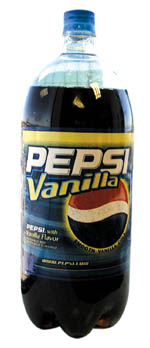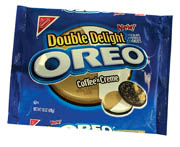
May 2004 Issue--According to the New Product Pacesetters report from Information Resources Inc. (IRI, Chicago), the number of 2003's new food and beverage products stood at 34,900, a drop from the previous two years. However, IRI is quick to note the numbers likely will rebound next year, when low-carbohydrate products begin to surpass the 52-week lifespan necessary to qualify as a Pacesetter.
Despite this low-carb promise, several non-carb-oriented products launched in 2003 achieved great success. Pepsi (Purchase, N.Y.) Vanilla and Sprite Tropical Remix (Coca-Cola, Atlanta) both placed among the top-selling launches, even though neither has been around for 52 weeks.
For that matter, among the “Pacesetter Candidates to Watch in 2004,” IRI does not list any products that tout their lack of carbohydrates. To be fair, though, Michelob Ultra from Anheuser-Busch (St. Louis), the first nationally marketed brand of beer to tout its low-carb aspect, managed $156.1 million in sales for its first 52 weeks, placing fourth on the Pacesetters list. What was the next-largest low-carb launch? Endulge nutritional bars from Atkins Nutritionals (Hauppauge, N.Y.) enjoyed $29.2 million in sales and served as the impetus for the company to team with CoolBrands (Toronto) and introduce super-premium ice creams and ice cream bars later in the year.
While sensory appeal was important, being healthful and convenient also were important goals for Dannon (Allentown, Pa.), which introduced Dannon Light 'n Fit Creamy. Indeed, the company is quick to note the unique recipe behind the non-fat yogurt. Consumers responded, to the point of $63.8 million in 52-week sales.

How Figures are Figured
IRI begins tracking sales of a new product once the product's distribution level reaches 30% of the nation. In order to qualify for this year's listing, a product's 30% distribution level must have been met between February 24, 2002, and December 28, 2003. In the past year, 749 food and beverage brands surpassed that criteria; however, to be considered a Pacesetter, IRI also demands that a product achieve at least $7.5 million in sales in the 52-week span. Some 117 of those required the full 52 weeks to clear the $7.5 million mark, but another 65 reached that plateau in less time, resulting in 182 total Pacesetters this year. In 2002, only 130 met the standards, while 2001 saw 153 Pacesetters.In fact, 2003 saw more Pacesetters than any of the previous nine years of Pacesetter reports. Wal-Mart (Bentonville, Ark.) sales data have not been included in IRI data since the end of 2001.
While there are a record number of Pacesetter products this year, their sales--on average--are smaller than those in the 2002 group. The largest decline is seen among the strongest-sellers, those with $50 million or more in sales. According to IRI, just over 2% of all new food and beverages surpassed that level.
Big Year for Beverages
One of the year's biggest surprises has to be Yellow Tail red and white wines from Casella Wines (Yenda, Australia). Named for the yellow-footed Rock-wallaby kangaroo and blended specially for the U.S., Yellow Tail enjoyed $77.3 million in sales, a surprise even for its bottlers. Casella sold 2.2 million cases and actually ran out of bottles at one point.While supplies were not quite as depleted elsewhere, the beverage category did place four entries among the top 10. Considering the quick success of Pepsi Vanilla and Sprite Tropical Remix, it could be said that six beverages ranked among the top 10. (See chart “Setting the Standard.”) The category's success permeated throughout the Pacesetter list. Some 34 of all 182 new beverage launches hit the $7.5 million sales mark, combining for a total of $1.5 billion in sales.
Vanilla proved its mettle, if 2003 launches are any indication. Vanilla Coke posted $292.1 million in sales, to take the top spot among Pacesetters. Certainly, the launch was not without its concerns. It was Coke's biggest and perhaps boldest new product since the infamous introduction of New Coke in 1985.
With the newest version of Coke, the company would attempt to hearken back to a simpler time. Press materials recalled 1950s soda fountains and promised, “Vanilla Coke offers the same true taste of Coca-Cola Classic with a hint of vanilla flavor,” extracted from vanilla beans.
Not to be outdone, PepsiCo added its own vanilla-enhanced colas (regular and diet versions) later in the year and met with similar success, albeit expectedly lower sales. Through 24 weeks of distribution, Pepsi Vanilla achieved $81.7 million, and IRI believes the product will reach the $150 million mark for full-year, 52-week sales. In so doing, it likely will be the leading Pacesetter next year.
Another beverage apt to appear next year will be Sprite Tropical Remix from Coca-Cola. Through 40 weeks of sales, the seasonal soft drink's $98.7 million haul puts it among this year's top seven. IRI believes the product will reach $120 million in 52-week sales, setting the stage for a competitive and beverage-laden 2004 Pacesetters report. Promising “another way to enjoy Sprite,” Chris Lowe, chief marketing officer with Coca-Cola North America, believes, “Sprite Remix will build on the brand's popularity in a way that is true to the personality of Sprite.”
Brand Valued
Having a well-known, established brand is integral to the Pacesetters. Over the nine reports, each of the most successful new foods and beverages was an extension of a familiar name or brand equity. IRI notes, “These extensions borrowed on the reputation and expectations of the core brand—be it Nabisco (now a part of Kraft, Glenview, Ill.), Coke, Pepsi, Folger's (a brand of Procter & Gamble, Cincinnati) or Frito-Lay--and brought some key innovation to the brand and the category: better-for-you, fat-free, a new focus of taste or standard of quality or restaurant quality.”Restaurant quality has been a particular focus in recent years, with new products capitalizing on Starbucks' (Seattle) and Boston Market's (Golden, Colo.) brand recognition. The restaurant-to-retail concept proved successful this year for Krispy Kreme (Winston-Salem, N.C.), the doughnut company.
The company itself is something of a phenomenon. Operating some 300 stores in 39 U.S. states, Canada and Australia, Krispy Kreme has been expanding rapidly in recent years. Canada's first store welcomed enough Toronto patrons to set a weekly company sales record of $465,000. Even in Sydney, Australia, where the company has little brand recognition, the first store registered about $300,000 during its first week. In the U.S., sales have been equally impressive. A Boston opening set a first-day sales record of $73,813. However, realizing that such numbers cannot be sustained, the company has set its target elsewhere--notably grocery stores and other retailers.
Some analysts worry the company will not be able to control the brand through such alternative distribution channels. First-year sales numbers show the retail aspirations of the company hold merit, however. In 12 months, Krispy Kreme doughnuts became the number-one brand in the doughnut category and tallied $235.5 million in sales, despite distribution levels below 50%.
Still, Krispy Kreme is not a rookie when it comes to grocery stores. In fact, its presence on the Pacesetters list is a bit of a misnomer. The other products on the list truly were launched during the timeframe under discussion. Krispy Kreme, on the other hand, has been selling its products in grocery stores for years, but only within the last year did it reach 30% national penetration.
Be that as it may, Krispy Kreme's efforts should not be ignored, as the company has convenience stores in mind, also. This may open the company to an enormous market with dire implications for such brands as Hostess (Kansas City, Mo.) and Little Debbie (Collegedale, Tenn.).
The success of Krispy Kreme indicates the opportunities of creating a powerful national brand, a trait mirrored by Sara Lee (Chicago), as the pair sought shelf space in categories long dominated by regional and local brands. Sara Lee reached nearly 60% national distribution on its way to $160 million in first-year sales of its line of fresh breads and rolls.
For its part, Sara Lee attempted to add value to the category, promising fresh bakery buns and rolls “richer in texture and more flavorful,” and featuring “wholesome” ingredients such as sugar, honey, milk and potato flour. The buns and rolls are larger than typical buns, a move Sara Lee says allows room for more fillings. Plus, the company boosted the appearance of its buns with a star-cut pattern on both the white and wheat varieties.
A nationwide advertising campaign soon followed, with print advertising in national magazines and commercials on national cable television channels. The effort proved fruitful, as Sara Lee became Sara Lee Bakery's largest domestic bread brand and the fifth-largest brand in the group's 33-state distribution area.
A focus on carb-cutting follows this effort, as Sara Lee is set to introduce low-carb “Delightful” bakery breads, including white and wheat. Each slice will have 9g of carbohydrates, compared with the traditional 15g in white bread and 13g in wheat. Nevertheless, Sara Lee's low-carb breads enter a rapidly growing market. Panera's (St. Louis), Nature's Own (Thomasville, Ga.) and Atkins Nutritional also are banking on bread with reduced carbohydrate levels.
Any reduced-carb efforts would be glad to mimic the success enjoyed by the aforementioned Michelob Ultra. In addition to its 2.6g of carbohydrates per 12oz. serving, Ultra has 95 calories and 4.2% alcohol by volume. Using “pale two-row and Munich six-row barley,” select grains, all-imported hops and a pure cultured yeast strain, Michelob says the choice of grains, plus an extended mash process, combine to produce the beer with fewer carbohydrates.
For the active consumer, Gatorade (a product of PepsiCo) added Ice to its growing stable of sports drinks. Formulated with the same 6% carbohydrate level as other Gatorade products, Ice clearly differentiated itself. That is, it differentiated itself by being clear. The colorless beverage incorporates glucose, identified as the carbohydrate most readily used by the body for energy. Available in orange, lime and strawberry flavors, Ice enjoyed $65.8 million in year-one sales.
Berry Burst Cheerios from General Mills (Minneapolis) garnered $88.5 million in 52 weeks. The first-ever pairing of Cheerios with real berries in the box was made possible by freeze-drying, a process essential to the strawberry and triple berry (strawberries, blueberries and raspberries) versions. Certainly, its convenience played a role in the product's success, but the manufacturer notes the freeze-drying process maintains the fruit's textural and nutritional characteristics.
As evidenced by the interest in weight loss and reducing carbohydrate consumption, consumers appear to be drifting away from the indulgent items that grew so popular in the wake of September 11. However, a pair of indulgences managed to eschew that trend, each expanding upon a proven brand, or in one case, several brands. Netting $54 million in year-one sales, the “Cookies &” line of cookie bars from Masterfoods USA (Hackettstown, N.J.) borrowed upon consumer recognition of Twix, Milky Way, Snickers and M&Ms, each of which were added to a cookie and gave the candy giant a foothold in another area of the store.
For the launch of a new Oreo item, Kraft's Nabisco Brands chose a familiar area of the store but also added something extra. Instead of one simple cream filling, the new Oreos boast two flavors in each cookie, either peanut butter and chocolate or mint and cream. With first-year sales of $78.4 million, an extension would seem inevitable, and the manufacturer did not disappoint. A coffee and crème version can now be found on shelves.
Despite these indulgent successes, IRI suggests, “The time is ripe for adding 'lighter, leaner or less of' to (brand) equities. Flavor and indulgence will take a back seat to nutrition.”
